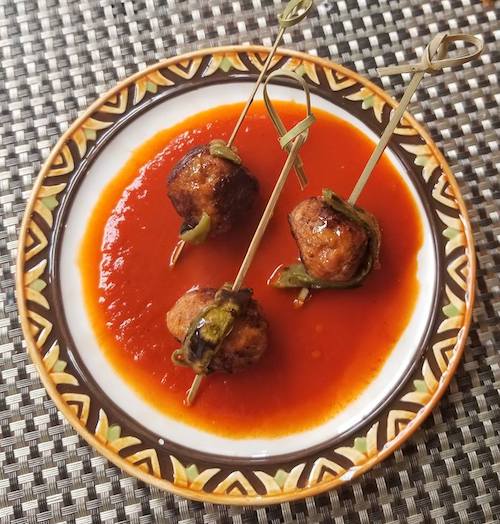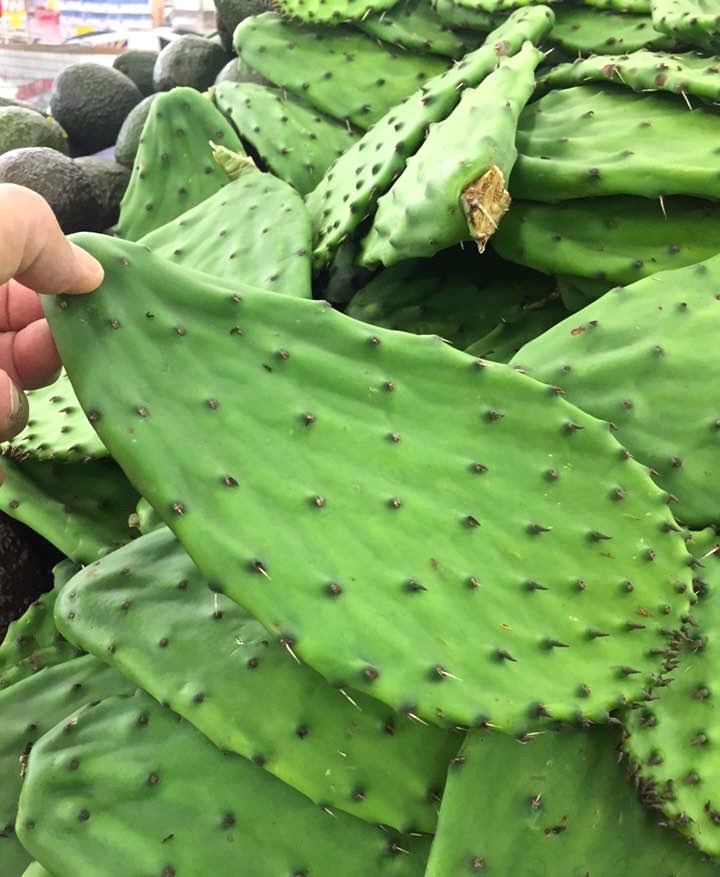Roasted Cactus, Chile Ancho Meatballs

I love these Roasted Cactus, Chile Ancho Meatballs because they’re perfect for parties.
Albóndigas illustrate the dynamism of food pathways, the routes by which foods travel via bird flights, human wars, marriages, and so on. As it travels, food changes, refashioning itself into new cultural types. This Texas Mexican meatball, albóndiga, originally comes to us from the Spaniards who arrived in the 1500s. “Albóndiga,” an Arab word, settled into Spanish cuisine because, of course, Spain was an Arab territory from 711 until 1492 when the Arabs were expelled militarily from the Iberian Peninsula.
The flavoring for this meatball is chile ancho, although chipotle is most commonly used in albóndigas throughout our region. I like the taste of the ancho because it reminds me of carne con chile. The rest of the recipe is straight from the Arabic Morocco, Spanish method: bread and eggs. Three native ingredients transform this Arab dish into Texas Mexican: Mexican oregano, chile ancho, and tomatoes. Roasting the meatballs, reduces fat and gives the albóndigas a crispy, tasty exterior that goes well with the adobo.
And the centerpiece of this “amouse bouche,” botana, is the Nopalito! It’s that special green, tangy taste of the cactus that makes this dish pop — the perfect Texas Native American, Indigenous botana.
Recipe:
Roasted Cactus, Chile Ancho Meatballs
–
Albóndigas de Chile Ancho con Nopalitos
Ingredients (makes 70 1-inch albóndigas)
For the Adobo
4 ancho chiles, seeded and deveined
1 white onion
3 garlic cloves
2 teaspoons fresh Mexican oregano
1 teaspoon salt
1 tablespoon canola oil
2 cups tomatoes, diced
2 cups chicken stock
1/4 teaspoon sugar
1/2 tablespoon white vinegar
For the Meatballs
1 pound ground pork
1 pound 96% fat-free ground beef
1 egg, beaten
2 teaspoons salt
3 ounces bread slices, crust removed, broken up into 1-inch pieces (about 1-1/2 cups or 3 slices)
1/2 cup milk
For the Cactus Strips
3 thin cactus paddles, at least 7” x 4” large, cleaned of all spines
Method
To Make the Chile Purée and Meatballs
Preheat the oven to 400°F.
1. Remove the seeds from the chiles by cutting a slit lengthwise in each chile to open it and remove the stem with the attached seeds. Remove all the other seeds in the chile pod.
2. Place the chiles in a large pot and cover them with water. Bring to a boil, turn off the heat, and let the chiles steep for 15 minutes so that they will rehydrate. Drain and allow to cool. Discard the water.
3. Place the chiles, onion, garlic, oregano, and salt in a blender. Add 1 cup of clean water and blend on high until the paste is completely smooth, with no large particles. Add a little more water if needed. If there are large particles in the paste after you are done blending, strain the paste through a fine-mesh sieve. Set aside.
4. Heat the canola oil in a Dutch oven and add the chile purée, with caution because there will be splatter as the liquid meets the oil. Fry for 10 minutes. The color will deepen and the purée will thicken. Set aside.
5. In a bowl, pour the milk, add the bread, and set aside.
6. Mix together the pork and beef.
7. Add the beaten egg and salt to the meat. Squeeze excess milk from the bread and mix it with the meat using your hands or a large spatula or spoon.
8. Add 8 tablespoons of the ancho chile purée to the meat and mix thoroughly.
9. Form the seasoned meat into 70 1-inch balls and place them on a large cookie sheet.

10. Roast the meatballs in a 400°F oven for 12–15 minutes until browned and crispy on the outside. Remove from the oven and allow the meatballs to rest for 10 minutes, or until you are ready to assemble with the cactus strips and the adobo.
To Prepare The Nopalitos (Cactus)
1. Place the cactus paddles on a comal or griddle, medium heat, and roast them for five minutes. Turn them over and roast for an additional five minutes, until the cactus paddles are fully cooked and soft. As they roast, they will develop black spots.
2. Slice the cooked cactus into 2 ¼”x ¼” strips and set aside.
To Make the Adobo
11. To the remaining chile purée add the tomatoes, chicken stock, vinegar and sugar and bring to a boil. Cook for 30 minutes until the adobo begins to thicken. Taste and correct the salt. (alternate between salt to raise the flavor volume and sugar to lower the acid level of necessary). Set aside.
To Assemble the Albóndigas
1. Wrap a strip of cactus snugly around each meatball and fasten with a toothpick. The cactus strip should snugly wrap around only half of each meatball.
TO SERVE: Ladle the adobo onto a chafing dish, or a skillet on the stovetop, then place the meatballs in the adobo to stay hot in the adobo sauce.